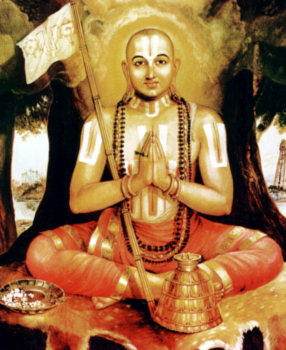 Nature of Jiva in the state of moksha is such that it acquires its truest and most real form. It is a common belief of almost all orthodox Indian philosophical systems that the individual self is eternal and different from the physical body and that at the time of death it leaves the body. In the case of an individual who has successfully completed the upasana on Brahman or bhakti yoga, the soul is believed to depart from the body through the crown of the head with the help of Paramatman and pass through the path of the gods until it reaches the realm of Brahman. Descriptive accounts of the exit of the soul (utkranti) and the divine path through which it passes have been given by the Upanishads. It is believed that the soul in the state of moksha manifests itself in its true form. It enjoys in full measure Brahman and its glory and attains a status of equality with Brahman. The soul does not become merged with Brahman but on the contrary, retains its individuality even in the state of moksha.
Nature of Jiva in the state of moksha is such that it acquires its truest and most real form. It is a common belief of almost all orthodox Indian philosophical systems that the individual self is eternal and different from the physical body and that at the time of death it leaves the body. In the case of an individual who has successfully completed the upasana on Brahman or bhakti yoga, the soul is believed to depart from the body through the crown of the head with the help of Paramatman and pass through the path of the gods until it reaches the realm of Brahman. Descriptive accounts of the exit of the soul (utkranti) and the divine path through which it passes have been given by the Upanishads. It is believed that the soul in the state of moksha manifests itself in its true form. It enjoys in full measure Brahman and its glory and attains a status of equality with Brahman. The soul does not become merged with Brahman but on the contrary, retains its individuality even in the state of moksha.
Thus the most important implication of these views is that the true nature of the soul which is omniscient in character becomes fully revealed only after reaching the state of moksha. Its knowledge is constrained in the state of bondage due to karma. With the total eradication of karma by the observance of upasana, the knowledge of jiva becomes fully manifest. Thus says the Chandogya Upanishad, "He who sees (Brahman), sees everything." The omniscience of jiva is not a quality which is newly acquired by the jiva in the state of moksha. It was already there as its inherent character. What was un-manifest in the state of bondage due to karma becomes now manifest in the state of moksha with the removal of the veil in the form of karma.
The Visnudharmottara makes this point more explicit with the analogy of gem and its lustre. The lustre of a gem when it is enveloped by dirt does not show itself but the same becomes manifest after the dirt is removed. Even as the lustre is not newly created when the gem is cleaned, jiva`s omniscience is not newly brought into existence. What was already inherent in jiva becomes manifest in the state of moksha. This is the implication of the, expression `svena rupena abhinis padyate` (manifests itself in its own true form), used in the Chandogya text.
Based on this Upanishadic statement the Vedanta Sutra uses the term avirbhava, which according to Ramanuja, means not a quality newly produced in jiva but a mere manifestation of its true nature that was already inherent in it. The removal of the veil in the form of karma is accomplished by the observance of upasana and the former can, therefore, be regarded as the goal to be attained (sadhya) by a sadhana or the spiritual discipline. In other words, the removal of bondage is the goal of spiritual discipline and the restoration of the true character of jiva in the state of moksha is a mere consequence of it. Thus philosophically, the nature of moksha in Visistadvaita is two-fold: removal of the bondage which is undesirable (anista nivrittih) and the re-gainment of the true character of the soul which is desirable (ista praptih). The former is important since the latter is consequential to it.
Thus it is evident from the foregoing discussion that the true nature of jiva becomes fully manifest in the state of moksha.









